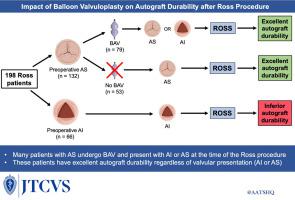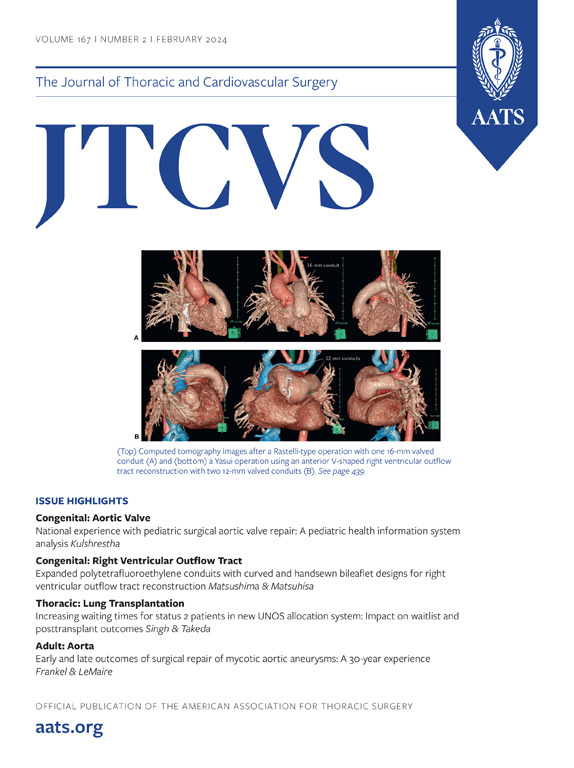球囊主动脉瓣成形术后的主动脉瓣功能不全不会影响罗斯手术后自体移植物的长期耐久性。
IF 4.9
1区 医学
Q1 CARDIAC & CARDIOVASCULAR SYSTEMS
Journal of Thoracic and Cardiovascular Surgery
Pub Date : 2024-11-01
DOI:10.1016/j.jtcvs.2024.01.024
引用次数: 0
摘要
目的:术前主动脉瓣关闭不全(AI)与罗斯手术后自体移植的耐久性较差有关。然而,许多主动脉瓣狭窄(AS)患者很早就接受了球囊主动脉瓣成形术(BAV),并在 Ross 术前就出现了长期的 AI。我们研究了 BAV 和随后的瓣膜病变对自体移植耐久性的影响:我们对 1993-2020 年间接受罗斯手术的患者进行了鉴定。方法:我们对 1993-2020 年间接受 Ross 手术的患者进行了鉴定,将 Ross 手术前接受 BAV 的患者与未接受 BAV 但因主要 AI(AI 组)或 AS(AS 组)接受 Ross 手术的患者进行了比较。之前接受过开放手术房室介入治疗的患者被排除在外。主要研究结果为自体移植失败,即自体移植再介入或严重功能不全:结果:共纳入 198 名患者。79名患者(39.9%)接受了BAV手术,随后因AI(45.6%)或AS(54.4%)为主接受了Ross手术。在未接受 BAV 手术的患者中,66 人(33.3%)为主要 AI,53 人(26.8%)为 AS。BAV组、AS组和AI组15年后自体移植失败的发生率分别为90%、92%和62%。AI组发生长期自体移植失败的风险明显增加(HR 5.6,P=0.01),而AS组和BAV组的风险相似且较低(HR 1.1,P=0.91)。Ross术前出现AS或AI的BAV患者的自体移植耐久性相似(P=0.84):结论:Ross术前BAV在AS患者中很常见。结论:Ross手术前BAV在AS患者中很常见,无论术前瓣膜病变如何,这些患者都有很好的长期自体移植耐久性,应积极考虑进行Ross手术。本文章由计算机程序翻译,如有差异,请以英文原文为准。

Aortic insufficiency following balloon aortic valvuloplasty does not impact long-term autograft durability after the Ross procedure
Objective
Preoperative aortic insufficiency (AI) is associated with inferior autograft durability after the Ross procedure. However, many patients with aortic stenosis (AS) undergo balloon aortic valvuloplasty (BAV) early and present with longstanding AI before Ross. We studied how BAV and subsequent valvular pathology impacts autograft durability.
Methods
Patients undergoing the Ross operation from 1993 to 2020 were identified. Those who underwent BAV before Ross were compared with patients who did not undergo BAV and underwent Ross for predominant AI (AI group) or AS (AS group). Those who underwent previous open surgical aortic valve intervention were excluded. Primary outcome of interest was autograft failure, defined as a composite of autograft reintervention or severe insufficiency.
Results
A total of 198 patients were included. Seventy-nine (39.9%) underwent BAV and subsequently underwent the Ross for predominant AI (45.6%) or AS (54.4%). Of patients who did not undergo BAV, 66 (33.3%) presented with predominant AI and 53 (26.8%) with AS. Freedom from autograft failure at 15 years was 90%, 92%, and 62% in BAV, AS, and AI groups, respectively. The AI group was at significantly increased risk of long-term autograft failure (hazard ratio, 5.6; P = .01), whereas the AS and BAV groups had similar, low risk (hazard ratio, 1.1; P = .91). Autograft durability was similar among patients who received BAV and presented with AS or AI before the Ross (P = .84).
Conclusions
BAV before the Ross procedure is common in patients with AS. These patients have excellent long-term autograft durability regardless of preoperative valvular pathology and should strongly be considered for the Ross operation.
求助全文
通过发布文献求助,成功后即可免费获取论文全文。
去求助
来源期刊
CiteScore
11.20
自引率
10.00%
发文量
1079
审稿时长
68 days
期刊介绍:
The Journal of Thoracic and Cardiovascular Surgery presents original, peer-reviewed articles on diseases of the heart, great vessels, lungs and thorax with emphasis on surgical interventions. An official publication of The American Association for Thoracic Surgery and The Western Thoracic Surgical Association, the Journal focuses on techniques and developments in acquired cardiac surgery, congenital cardiac repair, thoracic procedures, heart and lung transplantation, mechanical circulatory support and other procedures.

 求助内容:
求助内容: 应助结果提醒方式:
应助结果提醒方式:


